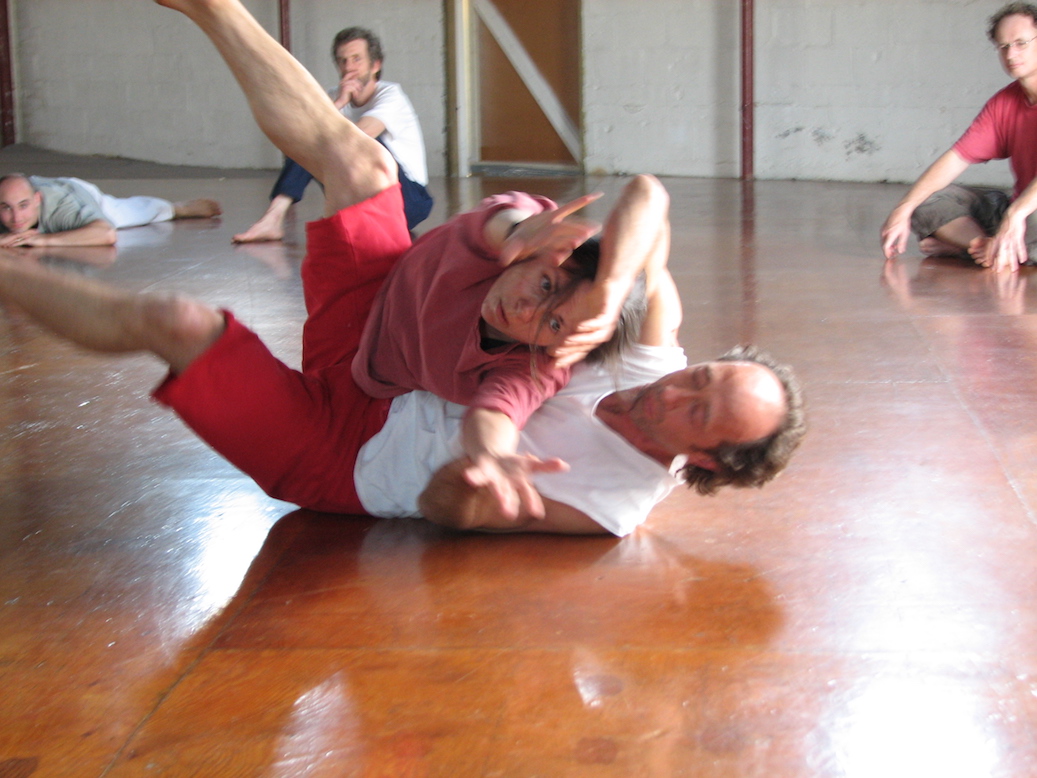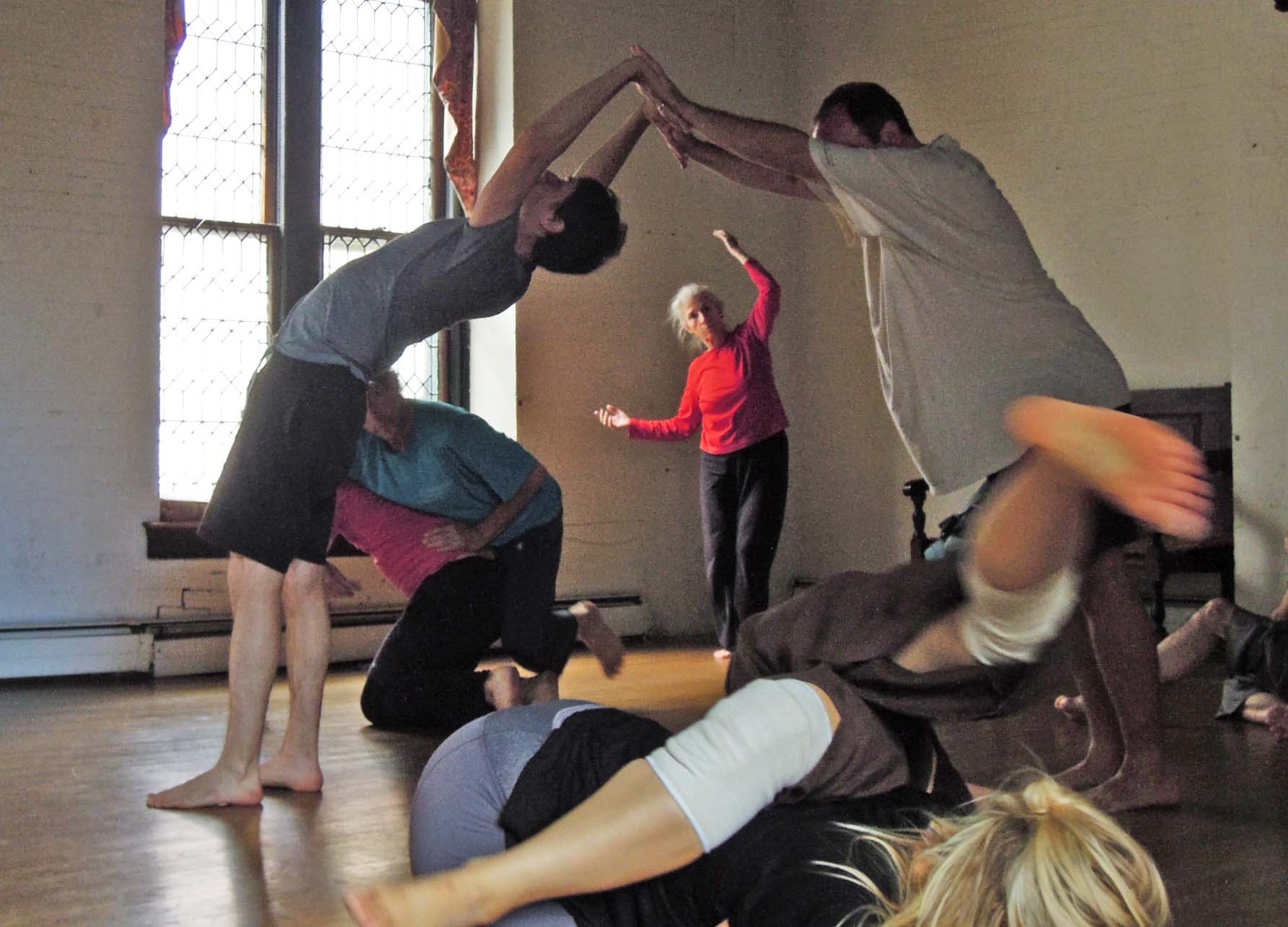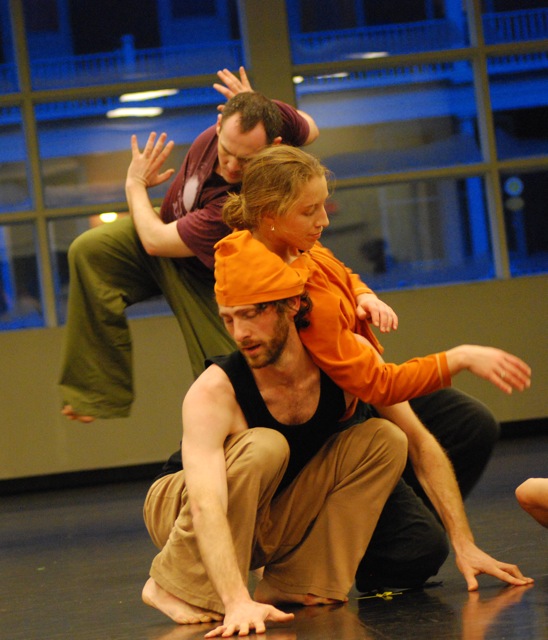CI Like and Unlike Other Partner Dance
I came up with this while preparing to teach CI to people who practice other kinds of partner dance, at a large dance festival. I wanted to get them ready for CI's different approach.
Where investing balance in following contact
points can go - Neige Christensen and Martin
Keogh
I relish sharing Contact Improvisation with others who might also enjoy it. That can be complicated because CI is structured differently than other partner dance styles in pretty fundamental ways. Some of the things you do to learn CI are different than what works for other partner forms, sometimes surprisingly so.
Steve Paxton's retrospective
notes of early CI development
I love what can happen when things click. Understanding CI's differences from and similarities to other partner dance can shed light on what CI is and what you do to find what works. I'll describe some essential differences, as well as some underlying similarities, and touch on some commonly taught central skills.
Contemporary dancers at jam, during a CI
anniversary celebration, CI36.
What is Contact Improvisation, and How Is It Different?
Contact improvisation is organized around an elementary premise: partners invest their balance in mutually following shared points of contact. While that's easy to say, you don't get much of a feel for how it works without actually trying it. However, it's easy to describe how it looks different from other partner practices:
- Contact Improvisation is a sort of partner dance, except there's no set music or steps or rhythms or, really, any set patterns to follow.
- It's sort of a meditation, except you're moving, sometimes very slowly and sometimes really fast and athletically, and often in ways that change over the course of a dance.
- In some ways it's like a sport or martial art, except that the aim is never defeating your partner. In fact, when it works you're playing for them and they for you.
- It's even like massage and partner yoga, except you both use your whole body while moving a little or a lot.
How Can It Work?
In most partner dance, partners move closely without getting all tangled up by using style-specific patterns - step sequences, rhythms, postures, pacing, roles and social protocols, etc. From there, the partners explore and develop skills for inhabiting that particular form of cooperation. CI instead uses that elemental task: following shared points of contact.
In any kind of partner dance, CI or not, when it works, it's exhilarating: cooperation so close and immediate, it's like the coordination that happens between the parts of your own body.
(See the video of Neige Christensen and Martin Keogh at the top of this article for some nice examples.)
So how do CI partners follow the contact point without getting all tangled up? By investing their centers, so their balance is at stake.
"Investing your center" is counterbalancing - leaning into the contact point, just a little is enough, or lightly holding your partner and leaning away - so your balance depends just a bit on the connection. When your balance depends on something, your mind fundamentally factors that thing into your sense of the situation. Learning to invest your center, and to pay close attention to what the contact point tells you about your partner's situation - and your own situation - is a lot of what learning contact improv is about.
Originally, Steve Paxton and others in the Judson Dance Project played with many "scores" - recipes - for exploring collaborative movement improvisations, including using the contact point. Steve was particularly interested in what happened when using the contact point, and decided to investigate that score further. Contact Improvisation grew out of it.
Specific skills, and how they're cultivated, may convey some feel for how it plays out.
Skills
Over time, practitioners developed exercises which evoke skills for navigating this unusual territory: ways to deal with gravity, momentum, the floor, the dynamics of communicating through the contact point, and more.
- Sharing Balance by Sharing Centers
Counterbalancing is familiar in most kinds of partner dance - holding each other and leaning away from or towards the shared center of balance, so that any change in position of one affects the other, and vice versa. A little is all it takes - in CI, the amount of weight can vary, from just enough to convey the gist of the cooperation, to taking rides on each other's trajectories, with full weight supported by one another. And anywhere in between.
By sharing centers, partners don't just communicate their movement, they share involvement in it by sharing the way we integrate our coordination, balance. - Working with the Floor
The floor is a constant partner in any dance form. In CI, we use it more ways than other forms do. For instance, falling is specifically avoided in most partner dance forms, but it's a regular part of CI. Learning to meet the floor in ways that redirects vertical momentum to horizontal takes out the sting, converts potential impact into gliding, to dancing. Learning to release into falls, rather than fighting them, is another crucial skill, whether falling together with a partner or not. Rolling on the floor is also an intrinsic part, and rolling with a partner even has a name, in CI: "body surfing".

- Sharing Weight
Exploring moving together with a shared center, you become acquainted with ways you can use your skeleton, rather than muscles, to support yourself and your partner without strain, and with fluidity. As it becomes ingrained, you can use it to bring rides higher into the air, without using force.
(Learning to act by responding to what you sense, using these skills to fit the moment rather than forcing some result, may be part of what is meant by a motto of one of CI's luminaries, Nancy Stark Smith: "Replace ambition with curiosity.")

- Sharing Rides
As the dynamics of sharing balance becomes familiar, partners can sense opportunities one to use each other's support to take rides - a kind of flying that, when done with attunement, can give everyone involved the feel of gliding together through space. (I know that people practicing other partner dance forms will recognize this experience, too.)
Diving Into Unknown – Erica Kaufman
- Doing Less, and Stillness
Not only can a CI duet's pace vary, full stillness is not unusual. In some moments, things settle. Maybe the dance is concluding, or maybe just changing. Sometimes if you feel overwhelmed, slowing down and even pausing allows you to catch up with the moment. At any time, stillness is an option.
Stillness is not just a CI movement option. Early on the inventor, Steve Paxton, came to see stillness as a crucial way to engage. See his retrospective account of the importance in The initiation of contact improvisation for me . Almost from the start, he shared some exercises that he calls "the stand" and "the small dance". See Steve Paxton's Small Dance Notes for some remarks from him about it.
How CI Practice is Typically Organized, and The Skill of Finding Your Way
While classes and workshops provide opportunities for people to share explorations and insights, most of the practice happens in gatherings, called jams, where it's up to the participants to get themselves ready to find their own dance, and eventually find dances with others, in their own time. This adds another layer of improvisation to the mix - how to start or recognize when a dance is starting, and when it's ready to be done, changing pace to suit either or both of your energy in the moment - it's all material for the collaboration.

Increasingly, a structure called the Underscore has been spreading around jams across the world. Devised and developed by Nancy Stark Smith, that development is being conveyed and continued by all those who practice it. The Underscore adds a layer of organization to the Jam structure, that layer helps jammers feel confident about being together with others in the process of finding their way. The DC Sunday jam has been practicing the Underscore on the first Sunday of each month since the end of 2003. We find that it helps newcomers find ease feeling part of the jam structure, while experienced dancers enjoy the cultivation of greater group spirit and focus without any squelching of the jam's open and improvisatory nature.
Toddler Sophie and father Itay Yatuv at an Ibiza jam
Last but not least: Play for the Sake of Play
Though not exactly a skill, yet not exactly not a skill, this is a good topic for wrapping up.
In daily life, it's too rare to find opportunities to use your whole body to really play, usemovement and relational skills that are fun to cultivate but that don't always apply to today's increasingly specialized world, where so much movement is done for you, and you have fewer opportunities to move yourself. Partner dance offers this opportunity. CI adds a twist - making more choices about the changing form of the collaboration. The pace, how energetic the dance is, many aspects are constantly renegotiated by the partners, seeking levels that suit each of them and that change as their needs change. It all can and does vary dramatically throughout the course of a single dance. How to respect what's going on in yourself, while also being attentive to your partner, this combination is a key skill for cooperating. Applicable to any kind of improvisation!
Paradoxically, while doing CI you may discover that it helps to be willing to be a bit awkward, to stumble rather than fighting imbalance, and by yielding to it find balance and flow. This lesson may be the one that's made the most difference for me, and that I continue to rediscover.
That's It
If any of this sounds intriguing, if you think you might enjoy these challenges and opportunities, please check it out. I'll be conducting a class on Sunday of Interfusion 2017, along the lines of the skills and exercises that I touch on above. You can also find details about the weekly DC CI jam at dccontactimprov.net, which happens every Sunday, rain or shine. For more that I've written about CI, see https://myriadicity.net/contact-improvisation.
